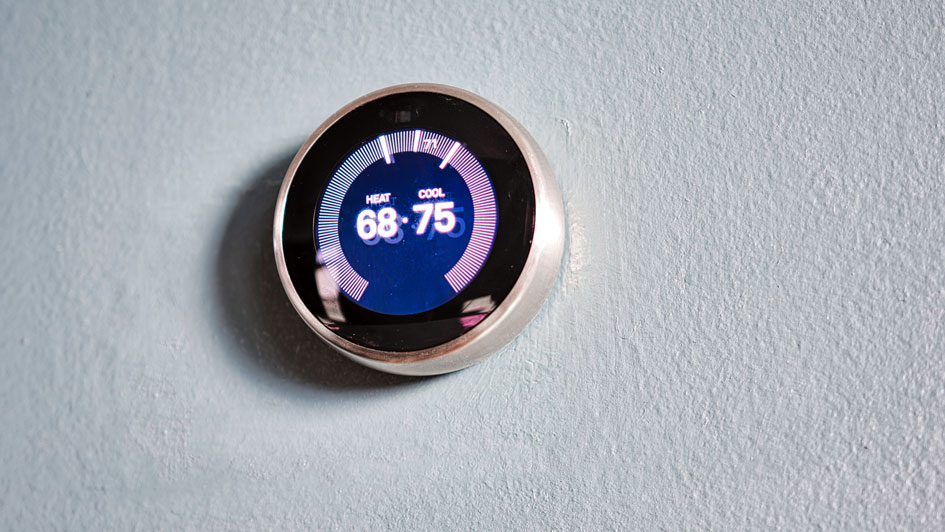
A Nest Thermostat is a great investment for keeping your home comfortable, regardless of the season or weather. With a range of features and programs designed for maximum efficiency, convenience and comfort, a Nest Thermostat is an excellent choice to help you manage your energy use — lowering your monthly bills in the process.
That’s why more homeowners are considering adding devices like a Nest to their homes. If you're interested in trying a Nest yourself, get in touch with an expert for smart thermostat installation in Elk River.
From auto scheduling to monitoring your home’s energy efficiency, Nest is designed to make securing your sense of comfort effortless.
Ready to learn more? Here’s a look at 12 things you should know about your Nest Thermostat.
1. Resetting Your Nest Thermostat
One of the first things to know about resetting a Google Nest Thermostat is that there's a difference between a restart and a reset.
- Restart: This process is similar across most electronics, including your phone or computer, restarting your Nest Thermostat means a quick off / on cycle. This records your existing thermostat settings, ad can reapply them once you're done confirming if your Nest is frozen or not connecting to Wi-Fi.
- Reset: A reset erases some or all of your settings. People normally only use a reset when they’re moving to a new home and bringing the thermostat with them, or if they're moving out and prefer to erase all personal info from the Nest before leaving it behind for the next resident.
To initiate a reset, it doesn't hurt to write down current temperature settings so reapplying them is faster. Next, find Settings -> Equipment and record your system wires, heating type and safety temperature settings.
Then, to manually restart or reset your Nest, go to Settings, select Reset and press. You will be presented with five options:
- Restart: Deactivates your Nest and reboots it while saving your settings. Another method is to press the outside of the Nest and hold it down for a few seconds until it goes black, and then pull your hand away.
- Schedule: This reset setting clears your entire temperature schedule—including for your hot water, if you have that programmed into your Nest. By choosing this kind of reset, you’ll have to input a new schedule or wait until the Nest learns your schedule.
- Away: An Away reset gets rid of any programming your Nest has picked up about how often you walk by, so that it can change the temperature accordingly.
- Network: With a network reset, it erases connection info and your Nest will no longer be connected to Wi-Fi. Use this option if you want your Nest to forget your Wi-Fi password.
- All Settings: Self-explanatory, an All Settings reset removes all your personal settings and learning.
2. How to Connect Nest Thermostat to Wi-Fi
Connecting to Wi-Fi is important to getting the most out of your Nest.
To connect your Nest to the internet:
- Access the Quick View menu. This is done by turning the thermostat's outer ring.
- Find the Settings icon.
- Select Network.
- Once your Nest scans available networks, locate your Wi-Fi and, if you have one, enter your password.
3. Does a Nest Thermostat Have a Battery and How Long Will the Battery Last?
Nest thermostats receive power from your HVAC system, but they also include a rechargeable lithium-ion battery for backup in situations where the power cuts out. According to Google, the maker of Nest, a Nest Thermostat battery will generally last several months. Recharge it with the USB cord that comes included.
4. Shutting Off a Nest Thermostat
If you aren’t going to be in your home for a long time, it's a good idea to set your Nest Thermostat to Off mode, though Eco mode would be another option. Using Off mode will turn off all of your regular heating and cooling schedules, while maintaining existing Safety Temperatures to keep your home from getting especially hot or cold.
To choose Off mode on the thermostat:
- Hold the touch bar until the display reads “Turn Off” before sliding the bar to highlight Turn Off, and then touch the bar to select.
- You can also go to Mode from the main menu and select Off.
Off mode is available on the Google Home app as well:
- Select Thermostat from home screen
- Tap Temperature mode
- Select Off
5. Is Alexa Compatible with a Nest Thermostat?
Yes, your Amazon Alexa can be used to control a Nest Thermostat. Alexa can also be integrated with with Nest doorbells and cameras. You can even operate a Nest Thermostat with Google Assistant.
6. Does a Nest Thermostat Function Without Wi-Fi?
The good news is that a Nest Thermostat will still be able to adjust the temperatures without Wi-Fi. However, without Wi-Fi a Nest doesn’t have the smart thermostat functions that most people enjoy.
7. Can You Lock a Nest Thermostat?
If you’re having a battle over the thermostat in your home between people who like things hot and others who prefer them cold, Nest offers a handy feature that keeps things simple.
Nest has a locking feature that allows a user to stop any temperature adjustments outside of a preset range. This doesn't mean you're stuck with a single temperature—a locked Nest still has access to programmed settings—but simply keeps these settings from being changed.
To lock a Nest:
- Press the Settings icon, scroll to the bottom and tap on Lock.
- Enter a 4-digit pin number you can remember, and do so twice.
- For locking a Nest in Heat or Cool mode, select your maximum and minimum temperature range and then press Lock at the bottom of the screen.
For unlocking it, open the settings and choose Unlock. Once you enter your 4-digit pin, the Nest will be unlocked.
8. Adjusting a Nest Thermostat from Your Phone
A Nest Thermostat is controlled by the Google Home app, which is accessible on your phone or desktop computer. Other versions of Nest, including the Nest Thermostat E and Nest Learning Thermostat, are also compatible with remote control via the Nest app.
Before you can make adjustments for a Nest on your phone with Google Home or the Nest app, you need to follow a few steps:
- Download the Google Home app or, with premium Nest models, the Nest app to your phone.
- Hook up your Nest Thermostat.
- Start the Google Home app on your phone and select the account, link to your new device and connect to Wi-Fi.
- Google has created a more comprehensive setup guide, for those needing extra assistance in connecting.
Once you’ve added your Nest to your Home app, you can access it by clicking Thermostat on the home screen. Once you do that, you can make changes to the temperature by dragging your finger along the screen or tapping on a plus or minus sign.
The preset temperatures on your Nest can also be changed from the app. From the home screen, find your Thermostat before selecting Settings. At this screen, press Temperature Preferences and then Temperature Presets. The display will show your preferred Comfort, Eco and Sleep temperatures. Choose the appropriate setting to change the temperature for that preset.
9. Creating a Nest Thermostat Schedule
You can set a temperature schedule on a Nest Thermostat either on the device or on the Google Home app. Newer and advanced models of the Nest, such as the Nest Thermostat E and Nest Learning Thermostat, are also controllable with the Nest app.
The two easiest ways to schedule your Nest are:
- Quick Schedule: Quick Schedules are based on the national average schedule for more energy-efficient use. When you are setting up your Nest, the Google Home app enables you to set the temperature with a schedule. When choosing this option, it presents a preset schedule for you to customize as you wish. Once setup is complete, that’s the schedule it will use.
- Temperature Presets: To change the temperature presets on your Nest, open the Google Home app and select Thermostat. Then, tap Presets and choose Edit. After the changes are complete, select Done.
For anyone wanting to edit their schedule, open the Google Home app, select Thermostat and then tap on Schedules. Choose the day of the week where you want to make changes. After the day is selected, tap Add and find the preset you want. Finally, select Time before touching and dragging the numbers to change the time. Select Done to save changes.
10. How to Set a Temperature Range on a Nest Thermostat
You can set a temperature range on a Nest Thermostat in the Eco mode. This is a function that adjusts the temperature in your home depending on if anyone is in the residence or if it is empty.
To customize the Nest temperature range in Eco mode, go to Settings and select Eco. The display will show any current “Heat to” and “Cool to” temperature settings. You can select each and make your preferred changes. When complete, select Done.
11. What to Do if a Nest Thermostat Is Not Compatible
A Nest Thermostat is compatible with most heating and cooling systems. The maker of Nest, Google, has an online compatibility checker that asks a series of questions about your location and existing setup to see which Nest model would be compatible with your system.
If you have a Nest and believe it’s not compatible with your system, it’s best to reach out to a professional for smart thermostat installation in Elk River. Technicians with the proper experience can assess your system and, if your Nest is compatible, install it quick so you can jump right into the savings and convenience.
12. Can I Manually Control My Nest Thermostat?
Nest Thermostats are packed with features designed to improve comfort while keeping costs low. However, you can actually turn off the smart features if you want to control a Nest manually like a normal thermostat.
Don't forget, by doing this you clear all your temperature schedules and letting the Nest work like any other thermostat—it will display the temperature and allow you to make changes, but that’s about it.
Setting your thermostat to manual controls can be accomplished with the following steps:
- Auto-Schedule: From the main screen, go to Settings and then scroll to Nest Sense. Go to Auto-Schedule, select No and click Done.
- Eco: From the main screen, go to Settings, scroll to Eco. Once in Eco, select Off for both the current Heat to and Cool to temperatures, and select Done.
- Home/Away Assist: From the main screen, go to Settings and select Home/Away Assist. Then, select Stop Using and click Done.
- Reset: Once you’ve turned off the settings, reset your nest. From the main screen, go to Settings and select Reset, highlight Schedule and then select Reset to clear out any saved scheduling data.

